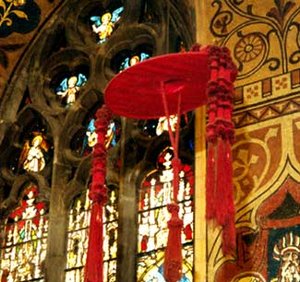Galero
|
|
Plural galeri.
Galero, in the Roman Catholic Church, is a large, broad-brimmed tasseled hat worn by clergy. Over the centuries it was eventually limited in use to individual cardinals as a crown symbolizing the title of Prince of the Church. When creating a cardinal, the Pope would crown the candidate with a scarlet galero in consistory.
Second Vatican Council
In 1969, a papal decree following the Second Vatican Council ended the use of the galero as an act of humbling the Church hierarchy. It was deemed that by removing such elaborate regalia, the people could better identify with their pastoral leaders. Today, only the scarlet zucchetto and biretta are placed over the heads of cardinals in consistory. However, some cardinals continue to obtain the galeros privately so that the old ceremony of its suspension over their tombs may be observed.
The galero is hung forever over the congregants of a cathedral, where they remain until they are reduced to dust, symbolizing how all earthly glory is passing.
Holy Name Cathedral in Chicago, Illinois, the Cathedral Basilica of Saint Louis in Saint Louis, Missouri, and the Cathedral of St. Matthew the Apostle in Washington, D.C. are three Cathedral churches in the United States that hang the galeros of past Cardinals on the ceilings.
Ecclesiastical Heraldry
| This article is part of the hats and headgear series: |
| Overview of headgear |
| Hats; Bonnets; Caps |
| Hoods; Helmets; Wigs |
| Masks; Veils; Scarves |
| Tiaras; Papal tiaras |
| Crowns; Types of crowns |
| List of hats and headgear |
The galero (or "ecclesiastical hat") is still in use today in ecclesiastical heraldry as part of the achievement of the coat of arms of an armigerous Roman Catholic cleric. It replaces the helmet and crest because those were considered too warlike for the clerical state. The color of the galero and number of tassels (sometimes termed houppes or fiocci) indicate the cleric's place in the hierarchy. A bishop's galero is green with six tassels. An archbishop's galero is also green but has ten tassels. Both patriarchs and cardinals have a galero with fifteen tassels, but the patriarch's is green while the cardinal's is red or scarlet. Even a priest uses the galero in his arms, but uses a simple black with two tassels. However, priests who hold additional offices, such as vicar general or abbot, or who have additional honors such as Chaplain of His Holiness gain additional tassels and different colored hats. Popes do not use a galero in their personal arms, rather the Papal Tiara and Keys of Saint Peter are used.
The depiction of the galero in arms can vary greatly, depending on the artist's style. Typically the top of the hat is a flat, and the brim is very wide. However, the brim can also be rendered much narrower, and the top can be domed. Such variants sometimes look like a cappello romano with tassels, but in heraldry it is still considered a galero.
External link
- Catholic Encyclopedia - Ecclesiastical Heraldry (http://www.newadvent.org/cathen/07243a.htm). Includes full list of galero color and tassel arrangements for heraldry, with illustrations.
Categories: Cardinal | Heraldry | Hats | Vestments

